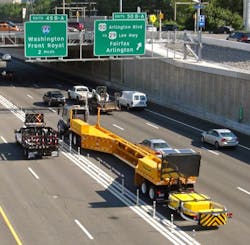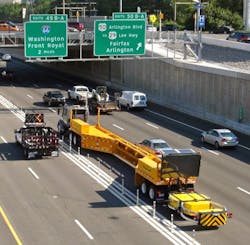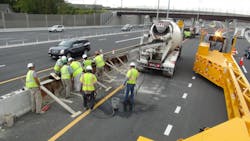A special memorial constructed by the Virginia Department of Transportation (VDOT) offers a particularly grim reminder of just how deadly highway work zones can be (you can view more photos of that memorial by clicking here.)
Yet a new type of safety barrier developed six years ago is trying to change all of that – a device designed to provide bigger and more robust protection for highway workers that also can put in place and removed far faster than more traditional barriers.
It’s called the MBT-1, designed and constructed by Mobile Barriers LLC, and many of the state DOT’s using this device consider it a “game-changer” in terms of how fast highway work zones can be set up and broken down, while boosting their protective attributes.
“Under prior practices, it was often not practical to set up protection and separate the workers and traveling public,” noted Kevin Groeneweg, CEO of Mobile Barriers, in a statement.
“To the extent there were only cones separating the two, there were more distractions which all too often lead to slowing and accidents,” he explained. “To compensate for dangers, crews often brought out extra trucks and/or took extra lanes or ‘buffer lanes.’ Now devices like the MBT-1 allow users to streamline the entire process. It simply pulls in place and crews can go to work. Later, it allows users to quickly re-open the road for rush hour – before most people even realize we were there.”
Groeneweg said MBT-1 barriers are delivered to a road work location via standard Class 8 tractor. After arriving on site, the barriers are positioned as needed and shield roadside workers from passing traffic. If needed, the barriers can be pulled along the roadway in incremental lengths until work is completed.
[They are also pretty robust, too, as the crash test video below attests.]
The Texas Department of Transportation (TxDOT) is one organization that’s a big believer in this device and is in the process of deploying more of them.
“Safety is our top priority and with these barriers, our workers are surrounded by a mobile, protective environment that allows them to get the job done more quickly and safely than would be possible with just cones,” John Barton, TxDOT’s deputy executive director, pointed out in a statement.
“There’s no better way to reduce work zone accidents and improve conditions for everyone than to safely complete the work as quickly as possible and reopen the roadway to normal traffic flow,” he said.
Can’t argue much with that calculation, can you?


